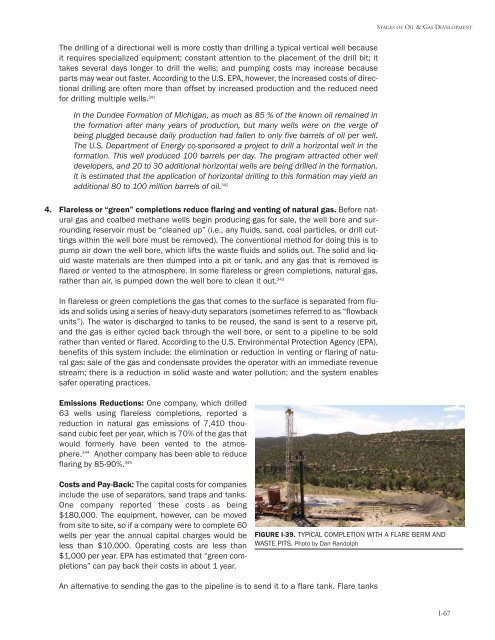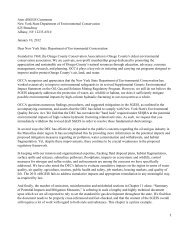Oil and Gas at Your Door? (2005 Edition) - Earthworks
Oil and Gas at Your Door? (2005 Edition) - Earthworks
Oil and Gas at Your Door? (2005 Edition) - Earthworks
You also want an ePaper? Increase the reach of your titles
YUMPU automatically turns print PDFs into web optimized ePapers that Google loves.
STAGES OF OIL & GAS DEVELOPMENT<br />
The drilling of a directional well is more costly than drilling a typical vertical well because<br />
it requires specialized equipment; constant <strong>at</strong>tention to the placement of the drill bit; it<br />
takes several days longer to drill the wells; <strong>and</strong> pumping costs may increase because<br />
parts may wear out faster. According to the U.S. EPA, however, the increased costs of directional<br />
drilling are often more than offset by increased production <strong>and</strong> the reduced need<br />
for drilling multiple wells. 341<br />
In the Dundee Form<strong>at</strong>ion of Michigan, as much as 85 % of the known oil remained in<br />
the form<strong>at</strong>ion after many years of production, but many wells were on the verge of<br />
being plugged because daily production had fallen to only five barrels of oil per well.<br />
The U.S. Department of Energy co-sponsored a project to drill a horizontal well in the<br />
form<strong>at</strong>ion. This well produced 100 barrels per day. The program <strong>at</strong>tracted other well<br />
developers, <strong>and</strong> 20 to 30 additional horizontal wells are being drilled in the form<strong>at</strong>ion.<br />
It is estim<strong>at</strong>ed th<strong>at</strong> the applic<strong>at</strong>ion of horizontal drilling to this form<strong>at</strong>ion may yield an<br />
additional 80 to 100 million barrels of oil. 342<br />
4. Flareless or “green” completions reduce flaring <strong>and</strong> venting of n<strong>at</strong>ural gas. Before n<strong>at</strong>ural<br />
gas <strong>and</strong> coalbed methane wells begin producing gas for sale, the well bore <strong>and</strong> surrounding<br />
reservoir must be “cleaned up” (i.e., any fluids, s<strong>and</strong>, coal particles, or drill cuttings<br />
within the well bore must be removed). The conventional method for doing this is to<br />
pump air down the well bore, which lifts the waste fluids <strong>and</strong> solids out. The solid <strong>and</strong> liquid<br />
waste m<strong>at</strong>erials are then dumped into a pit or tank, <strong>and</strong> any gas th<strong>at</strong> is removed is<br />
flared or vented to the <strong>at</strong>mosphere. In some flareless or green completions, n<strong>at</strong>ural gas,<br />
r<strong>at</strong>her than air, is pumped down the well bore to clean it out. 343<br />
In flareless or green completions the gas th<strong>at</strong> comes to the surface is separ<strong>at</strong>ed from fluids<br />
<strong>and</strong> solids using a series of heavy-duty separ<strong>at</strong>ors (sometimes referred to as “flowback<br />
units”). The w<strong>at</strong>er is discharged to tanks to be reused, the s<strong>and</strong> is sent to a reserve pit,<br />
<strong>and</strong> the gas is either cycled back through the well bore, or sent to a pipeline to be sold<br />
r<strong>at</strong>her than vented or flared. According to the U.S. Environmental Protection Agency (EPA),<br />
benefits of this system include: the elimin<strong>at</strong>ion or reduction in venting or flaring of n<strong>at</strong>ural<br />
gas; sale of the gas <strong>and</strong> condens<strong>at</strong>e provides the oper<strong>at</strong>or with an immedi<strong>at</strong>e revenue<br />
stream; there is a reduction in solid waste <strong>and</strong> w<strong>at</strong>er pollution; <strong>and</strong> the system enables<br />
safer oper<strong>at</strong>ing practices.<br />
Emissions Reductions: One company, which drilled<br />
63 wells using flareless completions, reported a<br />
reduction in n<strong>at</strong>ural gas emissions of 7,410 thous<strong>and</strong><br />
cubic feet per year, which is 70% of the gas th<strong>at</strong><br />
would formerly have been vented to the <strong>at</strong>mosphere.<br />
344 Another company has been able to reduce<br />
flaring by 85-90%. 345<br />
Costs <strong>and</strong> Pay-Back: The capital costs for companies<br />
include the use of separ<strong>at</strong>ors, s<strong>and</strong> traps <strong>and</strong> tanks.<br />
One company reported these costs as being<br />
$180,000. The equipment, however, can be moved<br />
from site to site, so if a company were to complete 60<br />
wells per year the annual capital charges would be<br />
less than $10,000. Oper<strong>at</strong>ing costs are less than<br />
$1,000 per year. EPA has estim<strong>at</strong>ed th<strong>at</strong> “green completions”<br />
can pay back their costs in about 1 year.<br />
FIGURE I-39. TYPICAL COMPLETION WITH A FLARE BERM AND<br />
WASTE PITS. Photo by Dan R<strong>and</strong>olph<br />
An altern<strong>at</strong>ive to sending the gas to the pipeline is to send it to a flare tank. Flare tanks<br />
I-67




